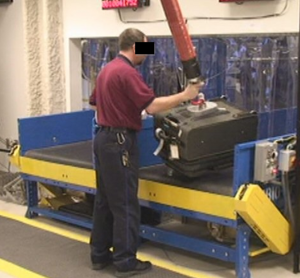Vacuum Lifting System to Reduce Spinal Load During Airline Baggage Handling
Posted on by
Did you know NIOSH has tested a vacuum lifting assist system to reduce spinal strain during airline baggage handling?
In collaboration with the Ohio State University, NIOSH published an article in Applied Ergonomics on the effectiveness of a vacuum lifting system in reducing spinal strain or loading during airline baggage handling. The study evaluated the techniques (i.e., manual lifting or lifting with vacuum lift system), task (i.e., loading or unloading suitcase), and baggage cart shelf height (61cm or 133.4cm) on lumbar spinal loads of ten subjects, who performed industry average loading and unloading tasks (e.g. 14.5kg) in a laboratory.
What We Found
We found that on average, use of the vacuum lifting assist device reduced compression and shear forces on the lower back by 39% and 25%, respectively. In fact, these forces were reduced below the damage threshold for musculoskeletal injury. The load reduction primarily results from the vacuum lifting device’s ability to support the entire weight of the bag. In addition, using the lifting assist device can result in better posture for lifting by keeping the back straighter.
Why This Matters
Approximately 45,000 baggage screeners and 173,700 baggage handlers are employed in U.S. airports by the Transportation Security Administration (TSA) and airline carriers, respectively. The maximum baggage weight can reach up to 70 lbs. or more. Lifting heavy weights repetitively has been identified as one of the main risk factors for musculoskeletal disorders. According to data from the Bureau of Labor Statistics (BLS), the overall annual incidence rate of work-related injuries resulting in days away from work, job transfer, or restricted work for the airport passenger transportation industry was 5.1% in 2015. This rate was more than 3 times the rate for the private industry (1.6%) as a whole, and the third highest in all job classifications used by BLS. Understanding risk factors of lifting techniques, lifting tasks, and the height of baggage cart shelves is the first step to improving work-related MSD prevention. Identifying how lifting assist devices reduce manual repetitive baggage lifting and handling can ultimately reduce the risk of MSDs.
Next Steps
We plan on sharing the study findings with safety professionals and worker unions in the airline industry. We would like to hear from you if you are interested in working with NIOSH on assessing the lifting assist device in the field to evaluate its productivity, usability and efficacy for reducing risk of injury. Please contact Jack Lu at mlu@cdc.gov, 513-533-8158 or use the comment section below.
Emily Warner, MA, is an ORISE Fellow in the NIOSH Division of Applied Research and Technology.
Jack Lu, PhD, CPE, is a Research Ergonomist in the NIOSH Division of Applied Research and Technology and Manager of the NIOSH Musculoskeletal Health Cross-Sector Program.
Resources for Employers and Employees to Reduce MSD Injuries
NIOSH Workplace Solutions: Reducing Musculoskeletal Disorders among Airport Baggage Screeners and Handlers
In-Depth Survey Report: Bag Handling Assist Controls for Airport Screening Processes
NIOSH Topic Page: Ergonomics and Musculoskeletal Disorders
NIOSH Publication: Elements of Ergonomics Programs
Website: OSHA baggage handling eTool
Guidance Document: TSA’s Planning Guidelines and Design Standards for Checked Baggage Inspection System
Website: UK Health and Safety Executive (HSE)
Posted on by

